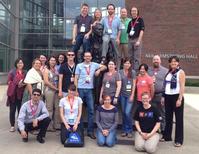PEER Collaborative Workshop
| Event Date: | June 19, 2014 |
|---|
PEER stands for Pine Mountain Engineering Education Research, in reference to the state park in Kentucky where a group of engineering education research colleagues came together in 2009. They gathered then to give each other advice, direction, and solace about their work as tenure-track faculty in a newly recognized academic discipline.
The workshop idea received support from the National Science Foundation (Grant No. 1129455). The funding led to workshops in 2011 (Athens, GA) and 2013 (Atlanta, GA).
The 2014 workshop at Purdue was underwritten by ENE (food and space) without additional NSF dollars. Nearly the same number of participants attended as did the previous year.

Dr. Jo Walther with the University of Georgia explains to his fellow PEER members the drawing on the whiteboard table in the i2i Demonstration Studio at Purdue.
“The key thing is that it is based on peer mentoring,” said Alice Pawley, ENE associate professor. “There weren’t the senior people available for the mentoring we felt we needed - most people didn’t get tenure in (engineering education research), and those who did were already really busy.”
Pawley, who served as a principal investigator on the NSF grant, said the 2014 PEER Workshop was an attempt at the group members helping themselves.
“We found value both in what we learned from each other and that we had insights to give too,” she said.
You can read the 2013 project outcomes report for the NSF HERE.
The "Zip" circle exercise is an improv exercise that helps a group warm up to actively engage in group discussions later in the morning. Participants form a circle, and the leader sends "energy" to someone else in the circle by making eye contact with someone, saying "zip," and making a directed hand motion. The recipient then sends the energy to someone else in the circle, and the cycle repeats. This game is valuable in that it helps participants to focus their energy on the group and actively participate by reacting.

